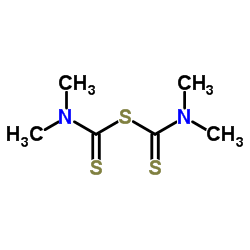Tetramethylthiuram sulfide

Tetramethylthiuram sulfide structure
|
Common Name | Tetramethylthiuram sulfide | ||
|---|---|---|---|---|
| CAS Number | 97-74-5 | Molecular Weight | 208.368 | |
| Density | 1.3±0.1 g/cm3 | Boiling Point | 260.9±23.0 °C at 760 mmHg | |
| Molecular Formula | C6H12N2S3 | Melting Point | 107-111 °C(lit.) | |
| MSDS | Chinese USA | Flash Point | 111.6±22.6 °C | |
| Symbol |


GHS07, GHS09 |
Signal Word | Warning | |
|
New antimony(III) halide complexes with dithiocarbamate ligands derived from thiuram degradation: The effect of the molecule's close contacts on in vitro cytotoxic activity.
Mater. Sci. Eng. C. Mater. Biol. Appl. 58 , 396-408, (2015) Antimony(III) halide complexes of the formulae {[SbBr(Me2DTC)2]n} (1), {[SbI(Me2DTC)2]n} (2) and {[(Me2DTC)2Sb(μ2-I)Sb(Me2DTC)2](+).I3(-)} (3) (Me2DTC = dimethyldithiocarbomate) were synthesized from SbX3, (X = Br or I) and tetramethylthiuram monosulfide (Me4... |
|
|
Occupational allergic contact dermatitis of the ears caused by thiurams in a headset.
Contact Dermatitis 65(4) , 242-3, (2011)
|
|
|
Enzyme inhibition as a possible mechanism of the mutagenicity of dithiocarbamic acid derivatives in Salmonella typhimurium.
Chem. Biol. Interact. 49(3) , 329-40, (1984) In recent years data have accumulated regarding genotoxic properties of dithiocarbamic acid derivatives. The results from the present work indicate that the mutagenicity of these compounds depends on an indirect effect via oxygen radicals. Mutagenicity of tet... |
|
|
Elicitation thresholds for thiuram mix using petrolatum and ethanol/sweat as vehicles.
Contact Dermatitis 34(6) , 410-3, (1996) An estimate of amounts of thiurams that may be released from rubber gloves into synthetic sweat, has previously been generated. These amounts should be compared to elicitation thresholds of patch tests performed with serial dilutions of thiuram mix using synt... |
|
|
Allergic contact dermatitis of the eyelids from rubber chemicals.
Contact Dermatitis 24(2) , 145-6, (1991)
|
|
|
Blood acetaldehyde levels in alcohol-dosed rats after treatment with ANIT, ANTU, dithiocarbamate derivatives, or cyanamide.
Drug Chem. Toxicol. 6(4) , 317-28, (1983) In adult female Wistar rats, pretreated by gavage with two doses - 16 or 256 mumol/kg - of cyanamide, TMTD (tetramethylthiuram disulfide), TMTM (tetramethylthiuram monosulfide), Ziram or Zineb at 90 min or 18 h before administration of 2 g of ethanol/kg i.p.,... |
|
|
Contact allergy to Nobecutan.
Contact Dermatitis 18(1) , 52-3, (1988)
|
|
|
Prevalence of type I allergy to natural rubber latex and type IV allergy to latex and rubber additives in operating room staff with glove-related symptoms.
Allergy Asthma Proc. 28(5) , 557-63, (2007) There is lack of data on the prevalence of latex allergy in the health care setting in Iran. This study was performed to determine the prevalence of type I latex allergy and type IV allergy to latex and rubber additives among the operating room staff with glo... |
|
|
Evaluation of contact sensitivity to formaldehyde and tetramethylthiuram monosulfide using a modified lymphocyte transformation test.
Toxicology 104(1-3) , 17-23, (1995) To examine the validity of a modified lymphocyte transformation test for evaluating contact hypersensitivity from weak sensitizers, guinea pigs were sensitized with formaldehyde (F) or tetramethylthiuram monosulfide (TMTM) using the maximization test procedur... |
|
|
Toxicity studies on tetramethylthiuram monosulfide.
Environ. Res. 28(1) , 199-211, (1982) Tetramethylthiuram monosulfide (TMTM), when given in a small dose of 26 mg/kg po, caused prolongation of the hexobarbital sleeping time in female Wistar rats. This effect was enhanced by increasing the dose to 867 mg/kg po and was associated with a lengthenin... |